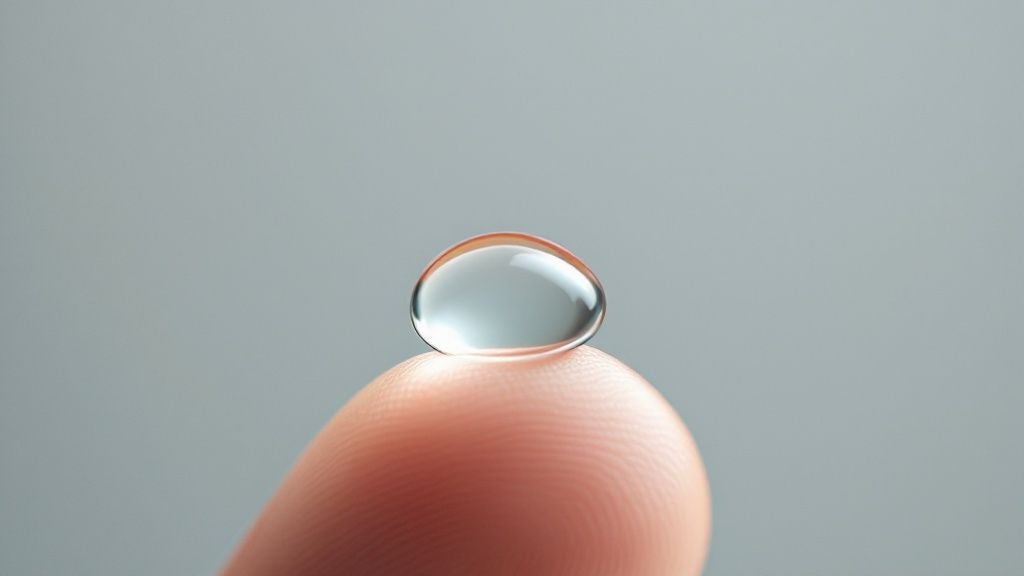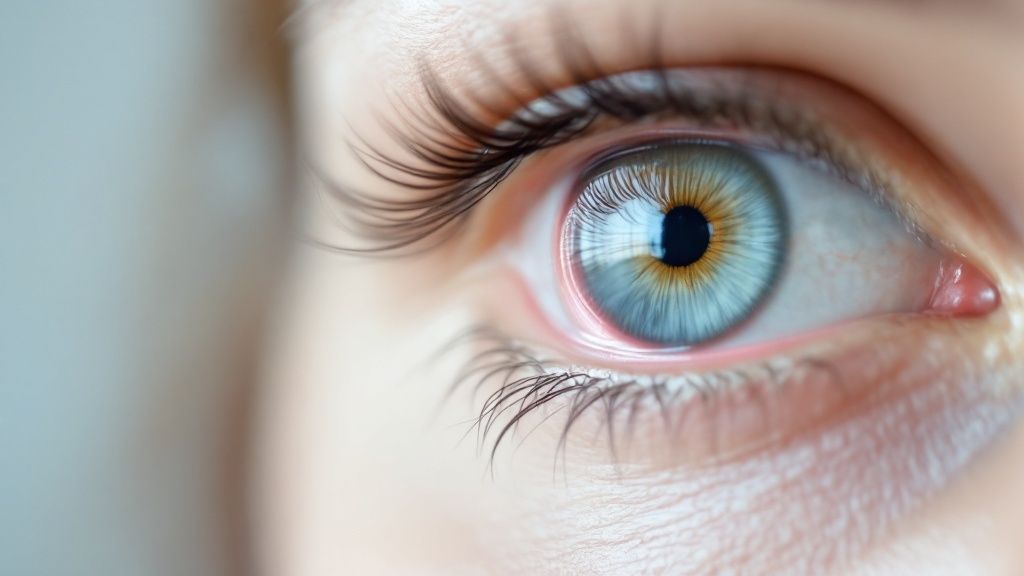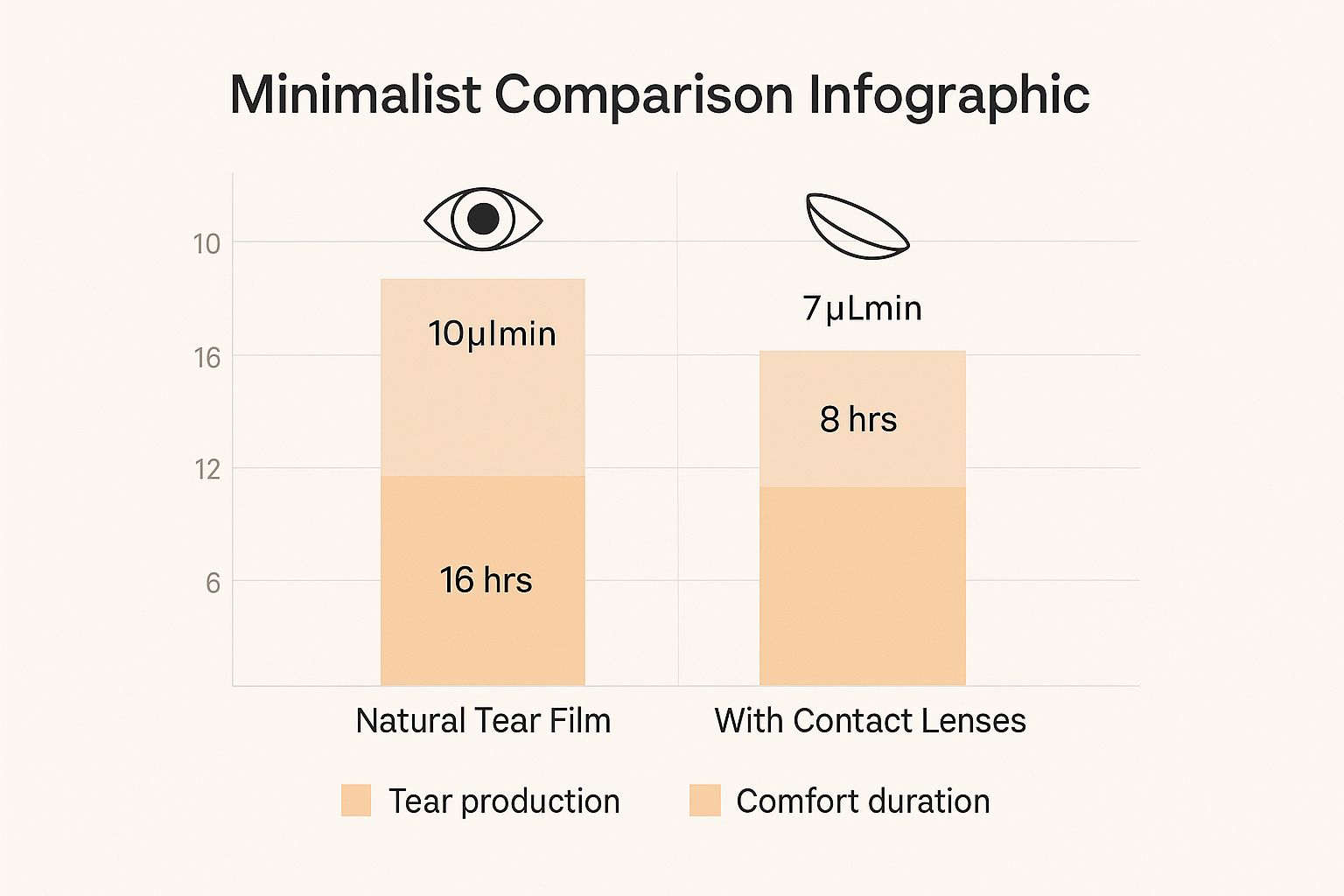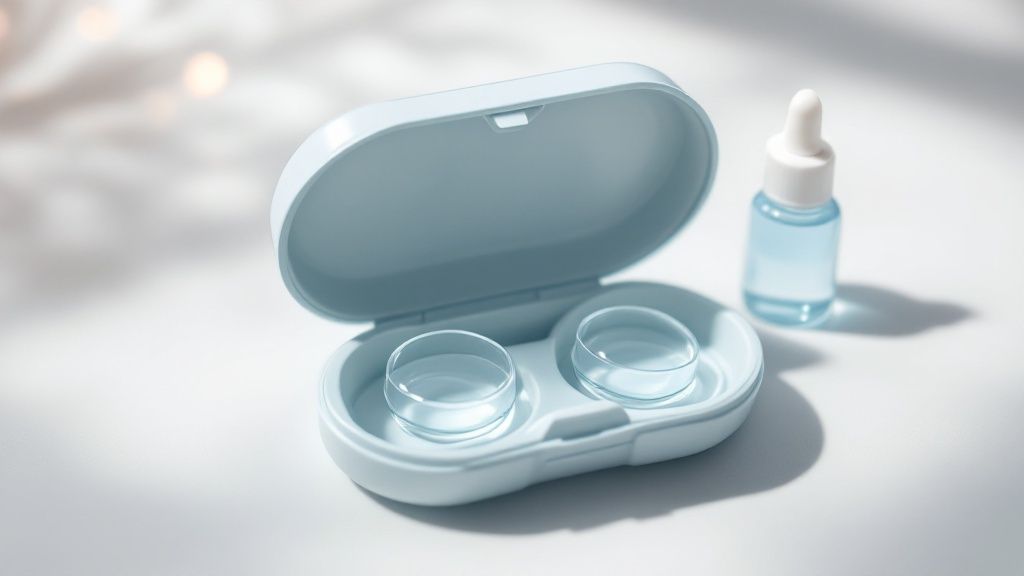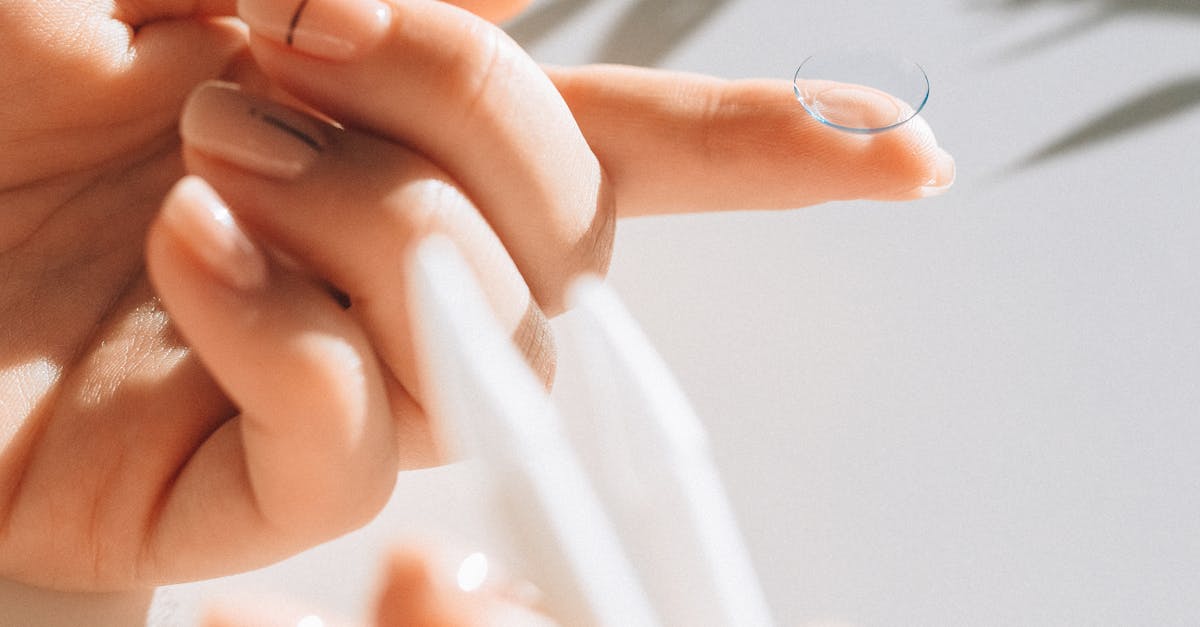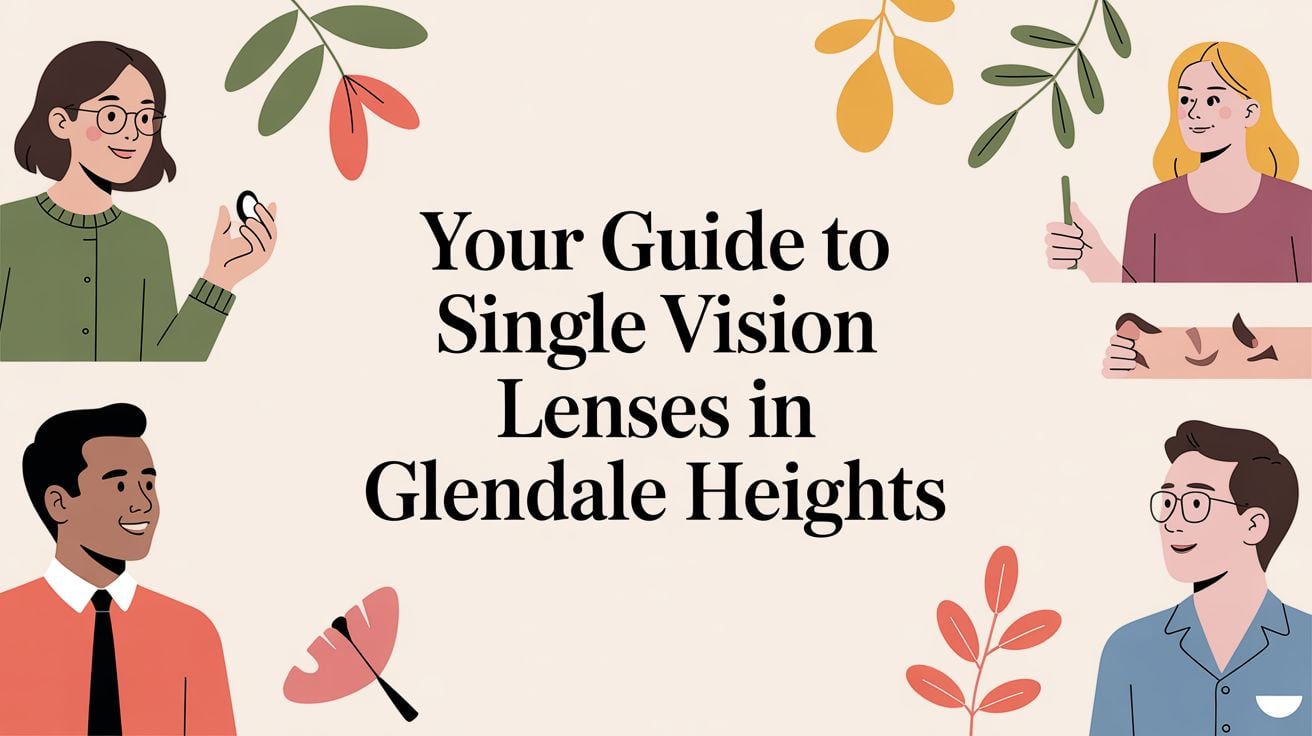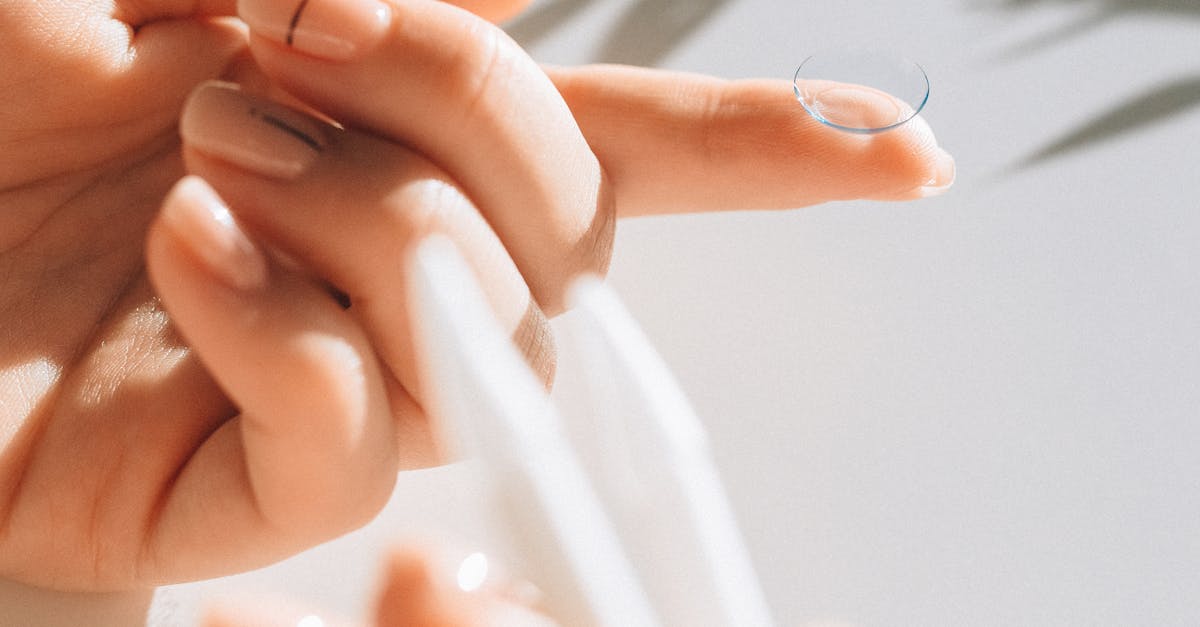If you wear contacts, that gritty, burning, or just plain uncomfortable feeling of dry eyes is probably all too familiar. For many of us here in Glendale Heights, dealing with this irritation is a daily struggle. What's happening is that the contact lens itself can interfere with your eye's natural tear film—the delicate, moist layer that keeps your vision clear and your eyes comfortable. The lens might soak up moisture or simply get in the way of tears spreading evenly across your eye's surface.
This disruption is what leads to that awful gritty, burning sensation and blurry vision. But here's the good news: relief is absolutely within reach, thanks to huge leaps in modern lens technology and a solid eye care routine from your local eye doctor in Glendale Heights.
Your Guide to Comfortable Contact Lens Wear in Glendale Heights
Welcome to our guide on finally solving the frustrating problem of dry eyes with contacts. If you've ever felt that sandy, irritated sensation after a day out at Camera Park or while driving down North Avenue, you are definitely not alone here in Glendale Heights.
You don't have to just put up with it. Let's dig into why your lenses might be causing this discomfort and explore some of the advanced, effective solutions we have available right here at iDoctor, a premier optometry boutique serving the Chicagoland suburbs.
A Widespread and Costly Issue
Contact lens-related dryness isn't just a small bother; it's a major health issue that affects millions. In the United States, it's estimated that up to 50.2 million Americans struggle with dry eyes, and it's one of the top reasons people ultimately give up on wearing their contacts.
The problem is so pervasive that dry eye disease costs the U.S. economy a staggering $55.4 billion annually in medical bills and lost productivity. These figures show just how serious and widespread this condition is.
Discomfort is the number one reason people give up on contact lenses. However, modern advancements in lens materials and personalized fittings mean that most people can wear contacts comfortably all day long.
This guide is designed to walk you through everything you need to know to achieve clear, comfortable vision. We're here to help everyone in Glendale Heights and the surrounding Chicagoland suburbs find lasting relief.
Quick Guide to Common Causes and First-Step Solutions
Getting to the root of your discomfort is the crucial first step. There are several different reasons you might be feeling that dry, irritated sensation, and pinpointing the cause helps us find the right solution. For a deeper dive into all your options, you can explore our guide to prescription contact lenses.
To get you started, here’s a quick summary of the most common culprits behind contact lens dryness and the first steps you can take to fight back.
| Common Cause | What It Feels Like | First-Step Solution |
|---|---|---|
| Poor Lens Fit | A constant feeling of a foreign object in your eye or lenses that move around too much. | Schedule a contact lens exam to ensure the lens size and shape are correct for your cornea. |
| Wrong Lens Material | Dryness that gets progressively worse throughout the day, often feeling better right after removal. | Ask your optometrist about silicone hydrogel or water-gradient lenses designed for better moisture retention. |
| Environmental Factors | Itchy, dry, or red eyes, especially in windy conditions or dry indoor environments (like a heated office). | Use preservative-free rewetting drops approved for contact lenses and consider using a humidifier. |
| Digital Eye Strain | Tired, strained, or blurry vision after spending long hours looking at a computer or phone screen. | Follow the 20-20-20 rule: every 20 minutes, look at something 20 feet away for 20 seconds. |
This table is a great starting point, but remember that a personalized consultation with an eye doctor is the best way to get a definitive diagnosis and a tailored treatment plan.
Why Your Contacts Make Your Eyes Feel Dry
To get to the bottom of contact lens-related dryness, we first need to look at how a healthy eye works. Your eye's surface is protected by a remarkably thin, three-layered shield called the tear film. Think of it as a tiny ocean of moisture, oil, and mucus that keeps your vision clear and your eyes feeling great all day.
When you put in a contact lens, you're placing a foreign object right on top of this delicate shield. It's no surprise that sometimes, this can throw off the natural balance your eyes work so hard to maintain.
The Tear Film Disruption
A contact lens can mess with your tear film in a couple of key ways. First, it can act like a tiny dam, physically blocking your tears from spreading evenly across your eye's surface every time you blink. This often leads to dry spots, which feel scratchy and can make your vision go blurry.
Second, the lens material itself can be the culprit. Some lenses, especially older types, tend to act like tiny sponges, soaking up the moisture right out of your eye. This dehydration process wicks precious moisture away from your cornea, causing that all-too-familiar gritty, dry feeling at the end of the day.
At its core, contact lens-induced dry eye is an issue of balance. The lens disrupts the natural, even distribution of your tear film, which is essential for lubricating the eye and ensuring crisp vision.
Two Types of Dry Eye Explained
It's also helpful to know that "dry eye" isn't just one single condition. It typically falls into two main categories, and contact lenses can make either one worse. Figuring out which type you have is a crucial step our team at iDoctor takes to find the right solution for you.
- Aqueous Deficient Dry Eye: This is a quantity problem. Your eyes simply don't produce enough of the watery part of your tears to keep everything lubricated, especially with a contact lens in the way.
- Evaporative Dry Eye: This is a quality problem. You might be making plenty of tears, but they disappear way too fast. This usually happens when the oily layer of the tear film, which is supposed to prevent evaporation, isn't doing its job.
The specific material and fit of your lenses can aggravate either of these issues. For example, a lens that doesn't fit quite right can physically block the tiny glands that produce the oils needed for a stable tear film, causing your tears to evaporate much faster. If you're curious, our team has created a helpful guide covering various dry eye treatment options available right here in Glendale Heights.
Local Factors That Make Dryness Worse
Don't forget about your surroundings—they play a huge role, too. Here in Glendale Heights, the changing seasons can be really tough on our eyes. The dry, forced-air heat we all blast during those long Chicagoland winters is notorious for sucking the moisture out of the air and, consequently, out of your eyes.
Likewise, even a fun day spent near the windy open fields at Glendale Lakes Golf Club can speed up tear evaporation, making even the most comfortable lenses feel dry and gritty. Pinpointing these triggers, from your lens material to the local weather, is the first step toward finding a personalized solution at your next eye exam.
Recognizing the Symptoms of Contact Lens Dryness
Contact lens dryness is sneaky. It rarely shows up overnight. Instead, it starts as a tiny bit of irritation that you might brush off. Before you know it, though, you're counting down the minutes until you can take your lenses out. Learning to spot these early warning signs is the key to finding relief and stopping the problem in its tracks.
The classic feeling of "dryness" is just one piece of the puzzle. The symptoms of dry eyes with contacts can manifest in a bunch of frustrating ways. It’s all about listening to what your eyes are telling you as you go about your day.
More Than Just Dryness
Think of the following as a quick checklist. If you find yourself nodding along to any of these while wearing your contacts, it’s a good sign your tear film is out of whack and needs some help.
- Gritty or Sandy Sensation: That persistent feeling like there’s a grain of sand stuck under your lens, even when you know there’s nothing there.
- Stinging or Burning: A sharp, uncomfortable burn that makes you want to squeeze your eyes shut.
- Redness and Irritation: Do your eyes look tired and bloodshot, especially after a few hours of wear? That's a classic sign.
- End-of-Day Discomfort: This one's a big tell. If you’re practically ripping your lenses out the second you walk in the door in Glendale Heights, your eyes are sending a clear signal.
These symptoms might be common, but they are definitely not normal. Just gritting your teeth and pushing through the pain won't fix anything—it just means your eyes are crying out for help. A proper evaluation can get to the bottom of the irritation.
The Impact on Your Vision and Life
Dryness doesn't just feel bad; it messes with your vision, too. You might notice things getting blurry when you're reading or working on the computer. A few hard blinks might clear it up for a second, but the blur always seems to creep back.
This unstable vision can make everyday life a real challenge. Driving at night down Army Trail Road can become tricky with all the glare and halos around headlights. For students at Glenbard North High School, long study sessions can turn into a battle against eye strain and headaches, making it tough to concentrate.
The most important thing to remember is that you don't have to just live with this. These symptoms are a clear prompt to get professional advice from your local Glendale Heights optometrist.
This problem is so common that it’s one of the top reasons people ditch contact lenses for good. Research shows that around 60% of contact lens wearers with dry eye have a mild form, but a significant 12% suffer from severe symptoms. In fact, discomfort is a huge factor, causing about 26% of new users to stop wearing lenses within their first year. You can read more about the connection between contact lens discomfort and dry eye diseases in recent studies.
And here’s a weird one: sometimes, a key symptom is excessive watering. It sounds backward, I know. But when your eyes get desperately dry, your brain panics and hits the emergency floodgates. The trouble is, these are low-quality "reflex" tears that don't have the right oils to stick around and lubricate. They just spill over and run down your cheeks, leaving your eyes as dry as before. Spotting these signs is the first real step toward finding a solution that actually works.
Finding the Best Contact Lenses for Dry Eyes
If your contacts start feeling like tiny, scratchy sponges by mid-afternoon, you're not alone. But you don't have to put up with it. The good news is that contact lens technology has come a long way, and switching to a different lens can completely transform your wearing experience.
The secret is to find a lens that works with your eye's natural tear film instead of against it. Modern lenses are engineered to either retain moisture more effectively or let more oxygen reach the cornea—both of which are critical for all-day comfort. This is exactly why a professional contact lenses in Glendale Heights fitting is so important; it’s about more than just your prescription. It’s about matching the right technology to your unique eyes.
The Power of Advanced Lens Materials
When it comes to comfortable contacts, the material is everything. For a long time, standard hydrogel lenses were the only option. The problem? They need to stay wet to work, and sometimes they do that by wicking moisture right out of your eyes, making dryness even worse.
Thankfully, we now have much better choices:
- Silicone Hydrogel: This material was a true breakthrough. Think of it like a high-tech screen door for your eye—it lets a ton more oxygen pass through to the cornea compared to older hydrogel lenses. Better oxygen flow keeps your eyes healthier and reduces the stress that often leads to that dry, gritty feeling.
- Water Gradient Lenses: This is one of the most exciting innovations in years. These lenses have a highly breathable silicone hydrogel core, but the surface is a super-slick cushion of moisture that's nearly 100% water. It feels silky smooth and helps your eyelid glide effortlessly over the lens with every blink, dramatically reducing friction.
Making a switch can be a night-and-day difference. Someone who could barely tolerate their old lenses for four hours might find they can comfortably wear a new silicone hydrogel or water gradient lens from morning to night.
This infographic clearly illustrates how the wrong lens can disrupt your eye's natural state, leading to reduced tear production and a much shorter window of comfortable wear.
As you can see, a standard lens can literally cut comfortable wear time in half. This highlights just how important it is to find materials designed to work in harmony with your eyes.
Why Daily Disposables Are a Top Choice
For anyone struggling with dry, irritated eyes, one of the best recommendations is often the simplest: daily disposable lenses. Imagine starting every morning with a perfectly fresh, clean, and sterile lens.
With dailies, there's no chance for protein deposits, allergens, or other gunk to build up—common irritants that can make dryness feel so much worse. You just toss them at the end of the day. As a bonus, you get to skip the hassle of cleaning solutions, which can sometimes cause their own sensitivity issues.
Daily disposables offer a clean slate for your eyes every morning. This simple change eliminates many of the common irritants that build up on monthly or bi-weekly lenses, providing a more comfortable and healthier wearing experience.
This isn't just a local issue; it's a global concern. A major 2022 study in Portugal revealed that a staggering 21.4% of soft contact lens wearers reported dry eye symptoms. The study, which you can read more about here, shows how widespread this problem is and why finding the right lens is so crucial.
Contact Lens Comparison for Dry Eye Sufferers
Choosing the right lens can feel overwhelming, but understanding the key differences in materials and designs makes it much easier. Each type offers unique benefits tailored to combat the symptoms of dryness.
Here's a quick breakdown to help you see how these options stack up:
| Lens Type/Material | Key Benefit for Dry Eyes | Best For | Replacement Schedule |
|---|---|---|---|
| Daily Disposables | Fresh, sterile lens every day; no deposit buildup or cleaning solutions. | Maximum hygiene, convenience, and allergy sufferers. | Daily |
| Silicone Hydrogel | High oxygen permeability keeps the cornea healthy and reduces stress. | Long-day wearers and those needing better eye health. | Daily, Bi-weekly, Monthly |
| Water Gradient | A nearly 100% water surface creates a cushion of moisture, reducing friction. | Individuals who feel their lenses at the end of the day. | Daily |
| Hydrogel | High water content provides initial comfort. | Budget-conscious wearers with minimal dryness issues. | Daily, Bi-weekly, Monthly |
This table shows there’s a solution for nearly every type of dry eye sufferer. While older hydrogel lenses can still work for some, the advancements in silicone hydrogel and water gradient technologies provide superior comfort and health benefits for those prone to dryness.
Knowing your options is the first step, but a professional fitting is where it all comes together. During your detailed eye exams in Glendale Heights, we can talk through these choices and find the perfect match for your eyes and lifestyle. To get a head start, take a look at our comprehensive guide on the best contact lenses for dry eyes. Your comfort is our top priority, and with the right lens, you can finally forget you're even wearing them.
Simple Lifestyle Habits for Lasting Relief
Finding the right contacts is a huge leap forward, but your daily habits play an equally critical role. Making a few small tweaks to your routine can dramatically improve how your eyes feel, working hand-in-hand with your lenses to keep you comfortable. Think of these habits as the essential backup your eyes need to stay happy and hydrated.
By weaving these simple strategies into your day, you can build a better environment for your eyes and cut down on the irritation that causes dry eyes with contacts. You'll be surprised at what a big difference these little changes can make.
Stay Hydrated and Mind Your Diet
This might sound like a no-brainer, but it all starts with water. When you're dehydrated, your body simply can't produce the high-quality tears needed to keep your eyes lubricated. Add a contact lens into the mix, and that moisture deficit becomes incredibly obvious.
Make a conscious effort to drink plenty of water all day long. This is the foundation for healthy tear production. What you eat matters, too. For a deeper dive into how your diet can help from the inside out, check out our guide on foods that promote excellent eye health.
Create a Better Environment
The space you're in has a huge effect on your eyes, especially during those notoriously dry Chicagoland winters. Cranking up the heat at home or in the office zaps humidity from the air, which in turn steals moisture right off the surface of your eyes.
The fix? Get a humidifier. Putting one on your desk or in your bedroom introduces moisture back into the air, slowing down the evaporation of your natural tears. It’s a small change that delivers a massive payoff in end-of-day comfort.
Master the 20-20-20 Rule
So much of our lives are spent staring at screens, and this is a major culprit behind dry eye for contact lens wearers. When we focus on a digital device, we forget to blink—in fact, our blink rate can plummet by as much as 50%. Since blinking is what spreads a fresh layer of tears over your eyes, less blinking equals drier, grittier-feeling eyes.
The 20-20-20 rule is your best defense against digital eye strain. It’s simple: Every 20 minutes, look away from your screen at something at least 20 feet away for 20 seconds.
This little exercise gives your focusing muscles a break and, just as importantly, reminds you to blink fully and remoisten your eyes and lenses. Set a timer to help you build the habit. It’s a game-changer.
Choose the Right Rewetting Drops
Even with the best lenses and habits, there will be times when your eyes just need a quick refresh. But it's crucial to understand that not all eye drops are safe for contact lenses.
Here's what you need to know to pick the right ones:
- Look for "Rewetting Drops": Only use drops that are specifically labeled as safe for use with soft contact lenses. Regular eye drops, especially the "get-the-red-out" kind, contain ingredients that can damage your lenses and cause serious irritation.
- Go Preservative-Free: The best rewetting drops often come in single-use vials because they are preservative-free. This makes them the gentlest option, especially if you need to use them frequently. Preservatives found in multi-use bottles can build up on your contacts over time, leading to more discomfort.
Think of preservative-free drops as a clean splash of water for your eyes—they provide pure, immediate relief without any unnecessary chemicals. For anyone in Glendale Heights struggling with dry contacts, they are without a doubt the smartest choice.
Your Next Steps With a Glendale Heights Optometrist
While lifestyle changes and new eye drops are fantastic first steps, they are often just one piece of the puzzle. If you’re still battling the frustrating symptoms of dry eyes with contacts, it’s time to stop guessing and get some professional guidance. Persistent discomfort isn't something you just have to live with, and lasting relief often requires a deeper look into what’s actually causing the irritation.
Think of it this way: at-home remedies often treat the symptoms, but a specialist gets to the root cause. If that gritty feeling comes back every afternoon, your vision blurs, or you find yourself peeling your lenses off the second you get home, those are clear signs your eyes need expert attention. Your best next step is to book a visit with the best optometrist in Glendale Heights for a precise diagnosis and a truly personalized treatment plan.
What to Expect During a Dry Eye Evaluation
When you come to iDoctor, we go far beyond a standard vision check. We take the time to understand your specific experience—from your daily routine in Glendale Heights to the exact type of discomfort you're feeling. Our 30-minute detailed eye exams give us the time we need to run specialized tests that get to the bottom of the problem.
Using high-resolution imaging and other advanced tools, we carefully assess a few key areas:
- Tear Film Quality: We don’t just check if you have enough tears; we analyze their quality. We'll look at the oily layer that stops evaporation and the watery layer that provides moisture to pinpoint exactly where the imbalance is.
- Gland Function: We examine the tiny meibomian glands along your eyelids. These are often the hidden culprits behind evaporative dry eye.
- Corneal Health: We make sure there's no underlying irritation or damage to the surface of your eye, which can be caused by dryness or poorly fitting lenses.
This thorough evaluation gives us the complete picture. It helps us figure out if your issue is from the wrong lens material, an underlying condition like evaporative dry eye, or even environmental factors unique to your life here in the Chicagoland suburbs.
A Personalized Path to Comfortable Vision
Once we understand the "why" behind your dryness, we can map out a plan built just for you. This might mean switching you to a modern water gradient or silicone hydrogel lens, prescribing specific therapeutic eye drops, or even recommending in-office treatments. The goal is always the same: to restore balance to your tear film so you can wear your contacts comfortably all day long.
For a full look at our fitting process, you can learn more about our specialized contact lens exams in Glendale Heights.
Don’t settle for discomfort as a normal part of wearing contacts. A professional evaluation is the most effective way to uncover the root cause of your dry eyes and find a solution that provides genuine, lasting relief.
And for those days when you just want to give your eyes a break, we can help you find the perfect pair of glasses. Our curated collection includes stunning frames from luxury brands like Cartier, Gucci, and Tom Ford, ensuring you see clearly and in style. Don't let dry eyes dictate your life—take the next step toward comfortable vision in Glendale Heights today.
FAQ: Your Questions About Contact Lens Comfort
If you're dealing with dry eyes while wearing contacts, you're not alone. We get a lot of questions from our patients here in Glendale Heights who are looking for relief. Here are some of the most common things people ask, along with our answers.
Can I really wear contacts if I have dry eyes?
Yes, you absolutely can. A dry eye diagnosis doesn't mean you have to give up on contacts for good. The trick is finding the right lens that works with your eyes, not against them.
This is where a professional fitting comes in. We'll take a close look at your unique tear film and eye shape to match you with the perfect material and design. For many people, newer options like daily disposables or advanced silicone hydrogel lenses—which let a ton of oxygen through—are game-changers. Our detailed eye exams in Glendale Heights are all about pinpointing that ideal solution for comfortable, all-day wear.
Will my vision insurance cover special contacts for dry eyes?
Most likely, yes. The great news is that almost all major vision insurance plans include a yearly allowance for contact lenses in Glendale Heights, and we’re happy to accept all of them here at iDoctor. While every plan is a little different, many offer significant benefits that you can put toward premium lenses designed specifically for dry eye relief.
Our team is fantastic at helping you make sense of your benefits. We'll work with you to maximize your coverage so you can get the best lens technology for your eyes without worrying about the cost.
Do you offer designer glasses for the days I take a break from contacts?
Of course! We're big believers in giving your eyes a rest, and we think you should look great while doing it. We have a carefully selected collection of designer eyeglasses in Glendale Heights, featuring stunning frames from top luxury brands like Cartier, Gucci, Oliver Peoples, and Tom Ford.
Giving your eyes a day off from contacts is one of the best ways to keep them healthy and reduce dryness. When you have a pair of glasses you truly love, it makes that break feel like a treat, not a chore.
We also carry stylish and popular frames from Ray-Ban, Kate Spade, and Coach, so there's something for every taste and budget. Our goal is to make sure you see clearly and feel fantastic, no matter what you're wearing.
Ready to find a lasting solution for dry eyes and finally enjoy comfortable contact lens wear in Glendale Heights? The experts at iDoctor are here to help. Schedule your personalized contact lens exam today and feel the difference that dedicated, expert care can make. Visit us online at https://idoctoril.com to book your appointment.


